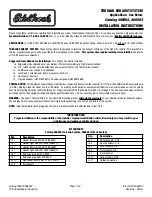
The transaxle will be in the “overdrive on” mode when the
vehicle is started even if the O/D OFF mode was selected when
the vehicle was last shut off.
If your vehicle is on an extremely slippery surface, the Electronic
Transaxle Control Module may receive a signal indicating a
rapid increase or decrease in wheel speed. If the module detects
this condition, it will limit the transaxle operation to Third
gear and Reverse. This reduces tire slippage and protects the
transaxle. The transaxle will operate normally in Reverse, but will
lack power during acceleration in Drive. If this happens, stop
your vehicle as soon as possible and turn the ignition off for 3
seconds. Restart the vehicle. If the condition still exists, contact your
dealer as soon as possible.
NOTE: If the O/D OFF indicator light is flashing on and off
repeatedly when the vehicle is started, there is a
transaxle electronic system malfunction. Contact your
dealer as soon as possible.
When to use 2 (Second)
Use Second (2) when driving on slippery roads or to provide
additional engine braking on downgrades. This position provides
Second gear operation only. Do not exceed 68 mph (108 km/h)
in this position.
When to use 1 (First)
Use First (1) to provide maximum engine braking on steep
downgrades. Upshifts from First can be made by manually shifting
to Second (2) or Overdrive (D). First (1) gear provides only first
gear operation. If you select First while driving at higher speeds, the
transaxle will shift to Second (2), and then shift back to First
(1) after the vehicle decelerates to the proper speed. Do not exceed
35 mph (56 km/h) in this position.
224
Summary of Contents for Villager
Page 2: ...Copyright 1997 Ford Motor Company ...
Page 4: ......
Page 12: ...Mechanical cluster 8 ...
Page 26: ...Electronic cluster 22 ...
Page 34: ...Electronic AM FM Stereo Cassette Radio 30 ...
Page 35: ...Premium Sound Radio Electronic Sound Syst ...
Page 36: ...Supersound with CD Changer 32 ...
Page 56: ...Notes 52 ...
Page 58: ...Instrument Panel Instrument panel 54 ...
Page 124: ...Notes 120 ...
Page 138: ...Using the seat belt guide with the three passenger bench seat in the second row position 134 ...
Page 176: ...2 If connected unbuckle the two safety belt tongues Also detach the chest clip 172 ...
Page 184: ...180 ...
Page 199: ...Adjustable Rear Seating 195 ...
Page 210: ...Notes 206 ...
Page 218: ...Notes 214 ...
Page 244: ...Notes 240 ...
Page 250: ...246 ...
Page 251: ...Roadside Emergencies 247 ...
Page 255: ...Roadside Emergencies 251 ...
Page 275: ...Sequence for connecting jumper cables Roadside Emergencies 271 ...
Page 278: ...Notes 274 ...
Page 325: ...Bulb locations Maintenance and Care 321 ...
Page 326: ...Bulb replacement chart 322 ...
Page 327: ...Maintenance and Care 323 ...
Page 328: ...324 ...
Page 329: ...Maintenance and Care 325 ...
Page 330: ...326 ...
Page 331: ...Maintenance and Care 327 ...
Page 332: ...328 ...
Page 340: ...Notes 336 ...
Page 342: ...338 ...
Page 343: ...Lubricant Specifications Automatic Transmission Fluid Capacities and Specifications 339 ...
Page 344: ...340 ...
Page 346: ...The engine compartment 342 ...
Page 348: ...Notes 344 ...
Page 363: ...Accessories 359 ...
Page 364: ...Notes 360 ...
Page 365: ...Notes Accessories 361 ...
Page 366: ...Notes 362 ...
Page 367: ...363 Q U I C K I N D E X ...
Page 368: ...Front Exterior View 364 ...
Page 369: ...Rear Exterior View ...
Page 370: ...Entrance View 366 ...
Page 371: ...Driver s Door ...
Page 372: ...Instrument Cluster Electronic 368 ...
Page 373: ...Instrument Panel ...
Page 374: ...Instrument Cluster Standard 370 ...
Page 375: ...Cargo Compartment ...
Page 376: ...Engine Compartment 372 ...
Page 396: ......
Page 397: ......
Page 398: ......
Page 399: ......
Page 400: ...Service Station Information 400 ...
















































